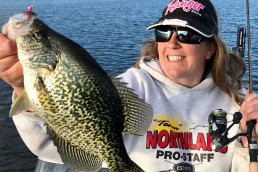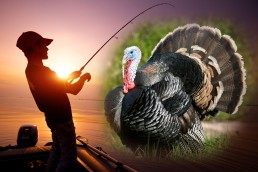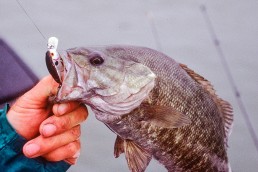The Temperament of Spring Crappies
SHARE THIS POST
Some years it feels like winter will never end, but they always do. Ice fishing can extend into April, but ice-out is what anglers really want once it gets this close to spring.
Many anglers in northern Minnesota will make the Rainy River the first place their boat gets wet in the spring.
The rules have changed in 2019 for the spring walleye season. Anglers are no longer allowed to keep any walleyes out of the Rainy River during the spring season. Some anglers may not be willing to make the long drive to the Rainy River if they can’t keep any walleyes. They may wait until their local lakes are open before making their first trips on open water this year.
Crappies are one of the first species many anglers look for when the ice goes out on the lakes in Minnesota. Members of the sunfish family, which includes crappies, spawn when surface water temperatures reach into the 60s and even the low 70s in some areas in the south.
Cracking the crappie code
Early season movements of crappies are related to pre-spawn feeding activities, rather than being related to the spawn. There are other species in the local lakes that spawn much earlier than crappies—species like walleyes, perch and northern pike, which all spawn shortly after the ice goes out, when water temperatures are in the mid 40s.
Crappies (mostly black crappies in my part of the country) have built-in thermometers and will effectively seek out the warmest water in the lakes to feed early in the season. This includes many backwater areas where anglers are challenged to get a boat into in order to fish.
The most important tools anglers can have for locating spring crappies is a good lake map or map chip to look for potential “classic spring spots” and a temperature gauge on their sonar/GPS units.
Crappies will find their way into some surprisingly remote locations where anglers wonder if their fins were sticking out of the water at some point in order to find their way into these locations.
Most good backwater areas for crappies will have a mud bottom, so they can find insects as well as minnows to feed. Minor insect hatches begin almost immediately after the ice goes out on the lakes in areas with a mud bottom. The dark mud also helps absorb the sunlight and makes the backwaters heat up much faster than the main-lake areas with a light-colored sand bottom.
Where fish feel safe
The backwater areas or shallow bays need to be deep enough to give the crappies a holding area to rest and feel safe when they are not feeding. Usually the minimum depth crappies will feel comfortable at is in 5 to 6 feet of water.
A good “rule of thumb” is if there is an area where the bottom disappears from sight, it is usually deep enough for the fish to feel safe. Most of the best backwater areas for crappies will have a hole somewhere nearby that is from 6 to 10 feet deep.
Are you enjoying this post?
You can be among the first to get the latest info on where to go, what to use and how to use it!
If the water is much deeper than 10 feet, the water is usually not warm enough to attract ice-out crappies. I use the temperature gauge on my Humminbird Helix 12 as the ultimate judge to find areas where the water temperatures are several degrees warmer than the average water temperatures in the rest of the lake.
If there are no “classic spring spots” for crappies in a lake, the crappies will still look for any areas that are protected from the wind and have a dark bottom that warms up faster than the rest of the lake.
On the hunt for sun-warmed wood
The angle of the sun in my part of the country causes the north and west parts of the lakes to warm faster than the south and east shores. I usually begin my search in those parts of the lake first. This includes bays which can be on the south end of the lake. It is the shoreline I am concerned with and any area with warmer water.
Wood is like a magnet for crappies in the spring, whether that means a brush pile or a tree that has fallen into the water and has become structure. Stumps can also be very good holding areas for crappies. They like to relate to something rather than just being in an open area.
Bog and cattails edges often have a sharp break of a few feet that creates a good edge to fish for spring crappies. Reed beds are also possible locations, with the clumps of weeds right next to a deep edge are also attractive areas for feeding crappies in the spring.
When I am searching for crappies, I often only need to find one crappie to give away the location of the school. I want to move quickly until I catch a fish and then I will slow down and zero in on the school.
New rigs and jigs
I usually have at least two types of rods rigged for spring crappies. I can barely contain my excitement to use my new St. Croix Legend Elite Panfish rods this spring. In my opinion, they are the best panfish rods I have ever seen.
Once of the techniques I use for spring crappies could be called “skimming”. I like to fish long casts and reel them in just under the surface with jigs that have some type of a blade, hair jigs or a jig on a safety spin spinner.
I like to use the Northland Whistler Jig, Thumper Jig or Fire-Ball Spin Jig. I often use a twister type body or an Impulse creature body on the jigs, to give them some action and scent.
I like the 7-foot or the 6.75-foot St. Croix Legend Elite panfish rods. With them, I can make longer casts and get a better sweep on the hooksets. I like to reel the jigs slowly, to keep them about 1 to 3 feet under the surface and to use pauses to give the crappies a window to strike.
I use the same rods for my bobber rigs. I like a slip bobber with a horizontal jig from 2 to 6 feet under the bobber, depending on the location I am fishing. I often fish the bobber rigs with a minnow or some type of live bait that I keep alive and fresh in my aerated Frabill Magnum Bait Cooler.
MWO
SHARE THIS POST
Did you enjoy this post?
You can be among the first to get the latest info on where to go, what to use and how to use it!
Brian 'Bro' Brosdahl
Outdoor communicator Brian “Bro” Brosdahl lives in northern Minnesota. He is a walleye guide in the Cass Lake, Leech Lake and Lake Winnibigoshish areas. He is sponsored by Northland Fishing Tackle, Frabill/Plano, Aqua-Vu, Humminbird/Minn Kota, St. Croix Rods, Ranger Boats, and Evinrude. Guide inquiries: brosguideservice.com. Follow on social media.



